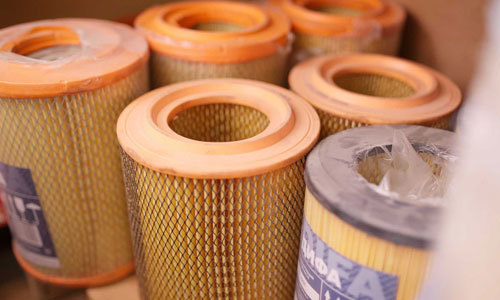How to Install a Hydraulic Oil Filter for Optimal Loader Performance
2025-10-05
How to Install a Hydraulic Oil Filter for Optimal Loader Performance
Installing a hydraulic oil filter is crucial for maintaining the efficiency and performance of your loader. A clean hydraulic system ensures that your machinery operates smoothly and effectively, reducing the risk of breakdowns and extending its lifespan. In this comprehensive guide, we will walk you through the steps to install
How to Install a Hydraulic Oil Filter for Optimal Loader Performance
Installing a hydraulic oil filter is crucial for maintaining the efficiency and performance of your loader. A clean hydraulic system ensures that your machinery operates smoothly and effectively, reducing the risk of breakdowns and extending its lifespan. In this comprehensive guide, we will walk you through the steps to install a hydraulic oil filter, explore the importance of regular maintenance, and provide tips for ensuring optimal loader performance.
Table of Contents
- 1. Importance of Hydraulic Oil Filters in Loaders
- 2. Understanding Hydraulic Systems in Loaders
- 3. Types of Hydraulic Oil Filters
- 4. Tools and Materials Needed for Installation
- 5. Step-by-Step Installation Guide
- 6. Common Mistakes to Avoid During Installation
- 7. Maintenance Tips for Hydraulic Oil Filters
- 8. Conclusion
- 9. FAQs
1. Importance of Hydraulic Oil Filters in Loaders
Hydraulic oil filters play a pivotal role in the overall functionality of loaders. They are designed to remove contaminants from the hydraulic fluid, which can include dirt, metal shavings, and other debris. Without an effective filter, these contaminants can circulate through the hydraulic system, leading to wear and tear on components, overheating, and ultimately, failure of the system.
By ensuring that your hydraulic oil is clean, you can significantly reduce the risk of hydraulic failure, improve the loader's efficiency, and enhance its performance. This is why regular inspection and replacement of hydraulic oil filters is essential for any loader operator.
2. Understanding Hydraulic Systems in Loaders
To appreciate the importance of hydraulic oil filters, it is essential to understand how hydraulic systems work. Loaders use hydraulic systems to perform tasks such as lifting and digging, relying on pressurized fluid to generate force.
The hydraulic system comprises several key components, including:
- **Hydraulic Pump**: Responsible for generating flow and pressure within the system.
- **Hydraulic Actuators**: These convert hydraulic energy into mechanical energy, enabling movement or operation of the loader's components.
- **Hydraulic Lines**: Pipes or hoses that transport fluid throughout the system.
- **Reservoir**: A tank that stores hydraulic fluid.
- **Hydraulic Oil Filter**: The component that filters out contaminants from the fluid.
Understanding these components allows operators to appreciate how vital the hydraulic oil filter is in maintaining the system’s integrity.
3. Types of Hydraulic Oil Filters
There are several types of hydraulic oil filters, each suited for different applications and environments. Understanding the options available can help you select the right filter for your loader.
- **Inline Filters**: Positioned along the hydraulic lines, these filters are designed to remove particulate contaminants from the fluid. They are readily accessible for maintenance.
- **Return Line Filters**: These filters are located in the return line from the actuator to the reservoir. They protect the hydraulic fluid as it returns to the tank, ensuring that any contaminants are removed before the oil is cycled again.
- **Pressure Filters**: Installed in high-pressure lines, these filters are designed to handle the demanding conditions of hydraulic systems, ensuring that only clean fluid reaches critical components.
- **Magnetic Filters**: These filters use magnets to attract and capture metallic debris. They are often used in conjunction with other filter types for enhanced protection.
Choosing the right filter depends on your loader's specifications and operating conditions. Always refer to your loader's manual for manufacturer recommendations.
4. Tools and Materials Needed for Installation
Before embarking on the installation of a hydraulic oil filter, gather the necessary tools and materials to ensure a smooth process. Here’s a checklist of what you’ll need:
- **New Hydraulic Oil Filter**: Ensure it’s compatible with your loader.
- **Wrench Set**: For loosening and tightening the filter.
- **Oil Catch Pan**: To collect any spillage during the replacement.
- **Rags or Towels**: For cleaning up any mess.
- **Funnel**: Helpful for pouring new hydraulic oil.
- **Safety Gloves and Goggles**: To protect yourself during the process.
Having these tools on hand will streamline your installation process and minimize downtime.
5. Step-by-Step Installation Guide
Now that you have all the necessary tools and materials, follow these detailed steps to install your hydraulic oil filter:
Step 1: Safety First
Begin by ensuring safety. Turn off the loader and disconnect the battery. This prevents any accidental movement during the installation process.
Step 2: Locate the Hydraulic Oil Filter
Identify the location of your loader’s hydraulic oil filter. Refer to the loader’s manual if you are unsure. It is usually located near the hydraulic reservoir or the hydraulic pump.
Step 3: Prepare for Removal
Place an oil catch pan under the filter to catch any hydraulic fluid that may spill during removal. This will help keep your workspace clean.
Step 4: Remove the Old Filter
Using the appropriate wrench, carefully unscrew the old hydraulic oil filter. Be cautious, as some fluid may escape. Allow the old filter to drain completely into the catch pan.
Step 5: Clean the Mounting Surface
Once the old filter is removed, clean the mounting surface with a rag to ensure no debris or old gasket material remains. This step is crucial to avoid leaks with the new filter.
Step 6: Install the New Filter
Before installing the new filter, apply a small amount of new hydraulic oil to the rubber gasket of the filter. This helps create a good seal and makes it easier to remove in the future. Screw the new filter onto the mounting surface by hand until it is snug. Avoid over-tightening, as this can damage the gasket.
Step 7: Refill Hydraulic Fluid
Check the hydraulic fluid level in the reservoir. Add new hydraulic fluid as needed to ensure that the system is filled to the recommended level.
Step 8: Reconnect the Battery and Test
After the installation, reconnect the battery. Start your loader and let it run for a few minutes. Check for any leaks around the new filter and ensure that the hydraulic system is functioning correctly.
Step 9: Dispose of the Old Filter
Properly dispose of the old hydraulic oil filter and any collected hydraulic fluid according to local regulations. Environmental safety is paramount.
6. Common Mistakes to Avoid During Installation
To ensure a successful installation of your hydraulic oil filter, be mindful of common mistakes:
- **Neglecting Safety Precautions**: Always turn off the loader and disconnect the battery before beginning the installation.
- **Not Cleaning the Mounting Surface**: Failing to clean the mounting surface can lead to leaks.
- **Over-tightening the Filter**: This can damage the gasket, leading to leaks.
- **Using the Wrong Filter**: Always check compatibility to avoid performance issues.
By avoiding these mistakes, you can ensure a smooth installation process and optimal performance from your loader.
7. Maintenance Tips for Hydraulic Oil Filters
Regular maintenance of hydraulic oil filters is essential for the smooth operation of your loader. Here are some tips to keep in mind:
- **Regular Inspection**: Check the hydraulic oil filter regularly for signs of wear or damage. Replace it according to the manufacturer's recommendations or when you notice a significant drop in performance.
- **Monitor Hydraulic Fluid Levels**: Keep an eye on the hydraulic fluid levels in the reservoir. Low fluid levels can affect performance and cause damage to the hydraulic system.
- **Change Fluid Regularly**: In addition to filter changes, schedule regular fluid changes as recommended by the manufacturer to ensure optimal system performance.
- **Keep the System Clean**: Regularly clean the area around the hydraulic system to prevent dirt and debris from entering the system during maintenance.
Maintaining your hydraulic oil filter and system helps ensure longevity and peak performance, saving you money on repairs and downtime.
8. Conclusion
Installing a hydraulic oil filter is a straightforward yet critical task that can significantly enhance the performance and longevity of your loader. By following the step-by-step guide outlined in this article, you can ensure that your hydraulic system operates efficiently and effectively. Remember, regular maintenance and timely replacement of your hydraulic oil filter are key to keeping your loader in peak condition. With the right knowledge and tools, you can take control of your loader's performance and tackle any job with confidence.
9. FAQs
1. How often should I replace my hydraulic oil filter?
It is generally recommended to replace the hydraulic oil filter every 1,000 hours of operation or according to the manufacturer's guidelines.
2. What are the signs that my hydraulic oil filter needs replacing?
Signs include reduced performance, unusual noises, or fluctuations in hydraulic fluid levels. A visual inspection may also reveal leaks or discoloration.
3. Can I clean and reuse my hydraulic oil filter?
Most hydraulic oil filters are designed for single use. Cleaning and reusing them can compromise their effectiveness.
4. What type of hydraulic oil should I use in my loader?
Refer to your loader’s manual for the specific type of hydraulic oil recommended, as different loaders may require different fluids.
5. Is it necessary to change hydraulic fluid when changing the filter?
While not always necessary, it is a good practice to change the hydraulic fluid regularly, especially if it appears dirty or contaminated.
By adhering to these guidelines, you will enhance your loader's performance and ensure a longer lifespan for your equipment.
Key words:
Related News
How often does the air filter change?
The air filter element is mainly used to block impurities such as dust and sand in the air.
2024-05-22
What are the car filters? When do car filters need maintenance?
As an oil filter, it is generally replaced together with the oil during maintenance.
2024-05-22
The choice of filter manufacturers should be considered comprehensively
Before choosing a filter manufacturer, you must understand the relevant background of the manufacturer.
2024-05-22










